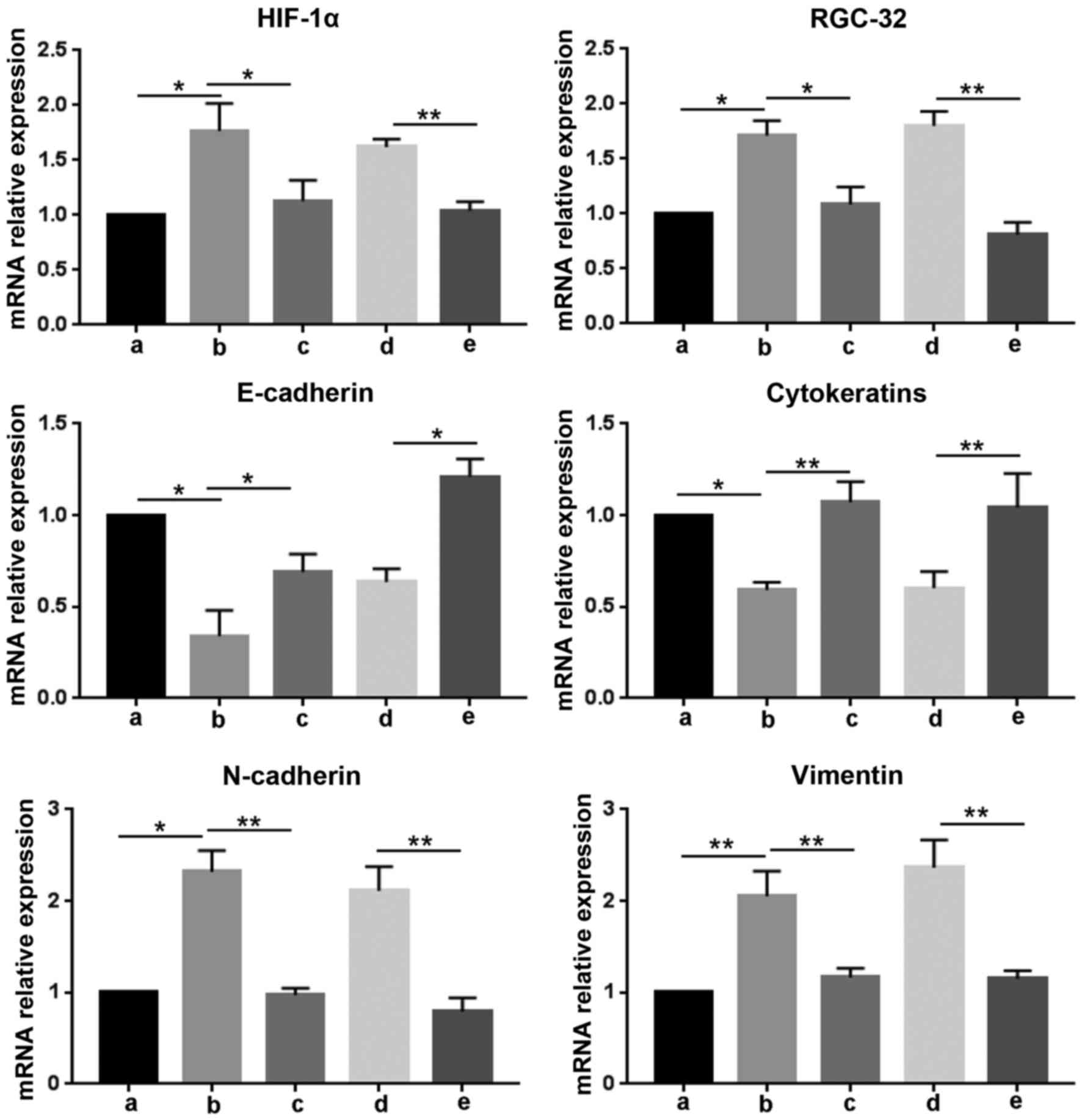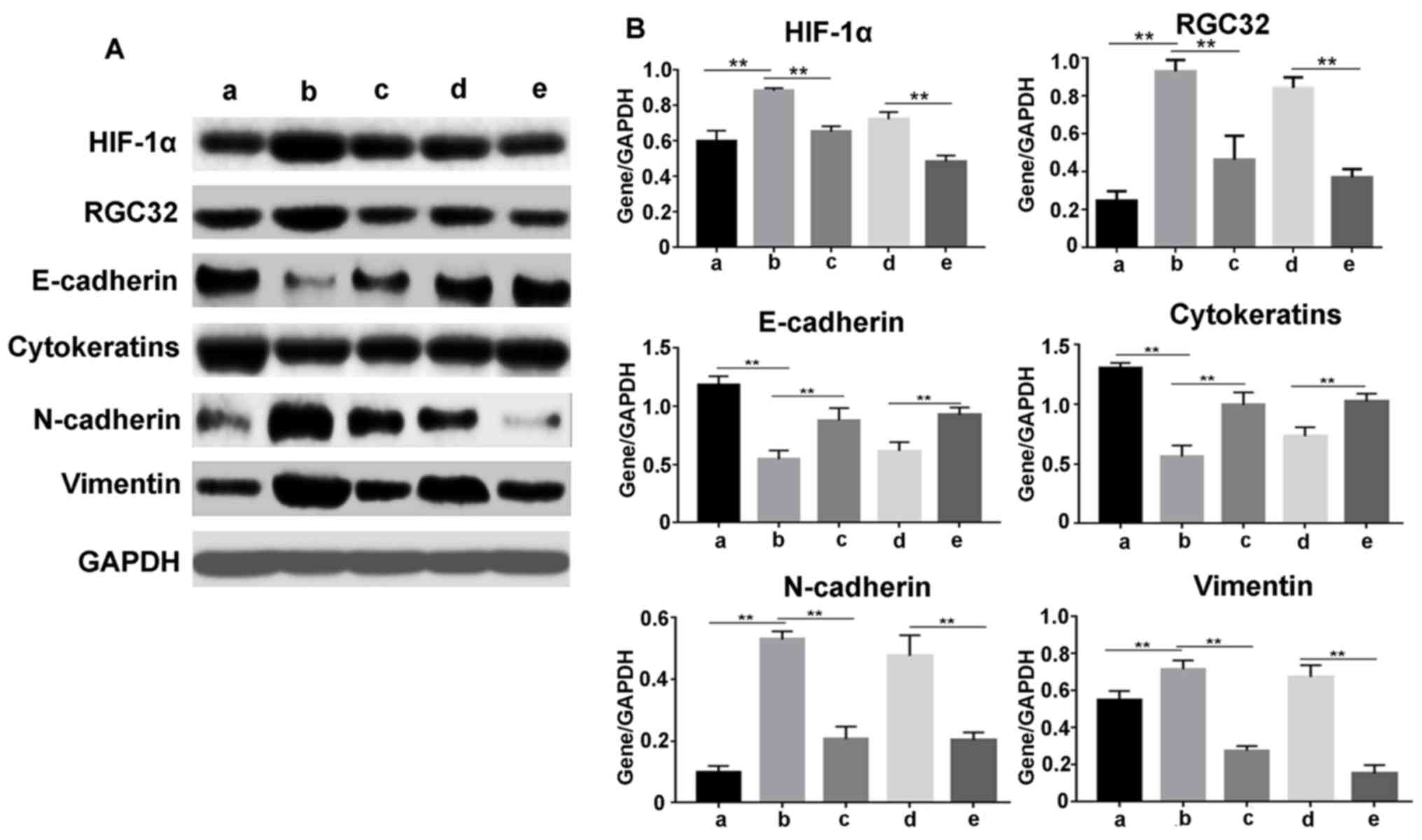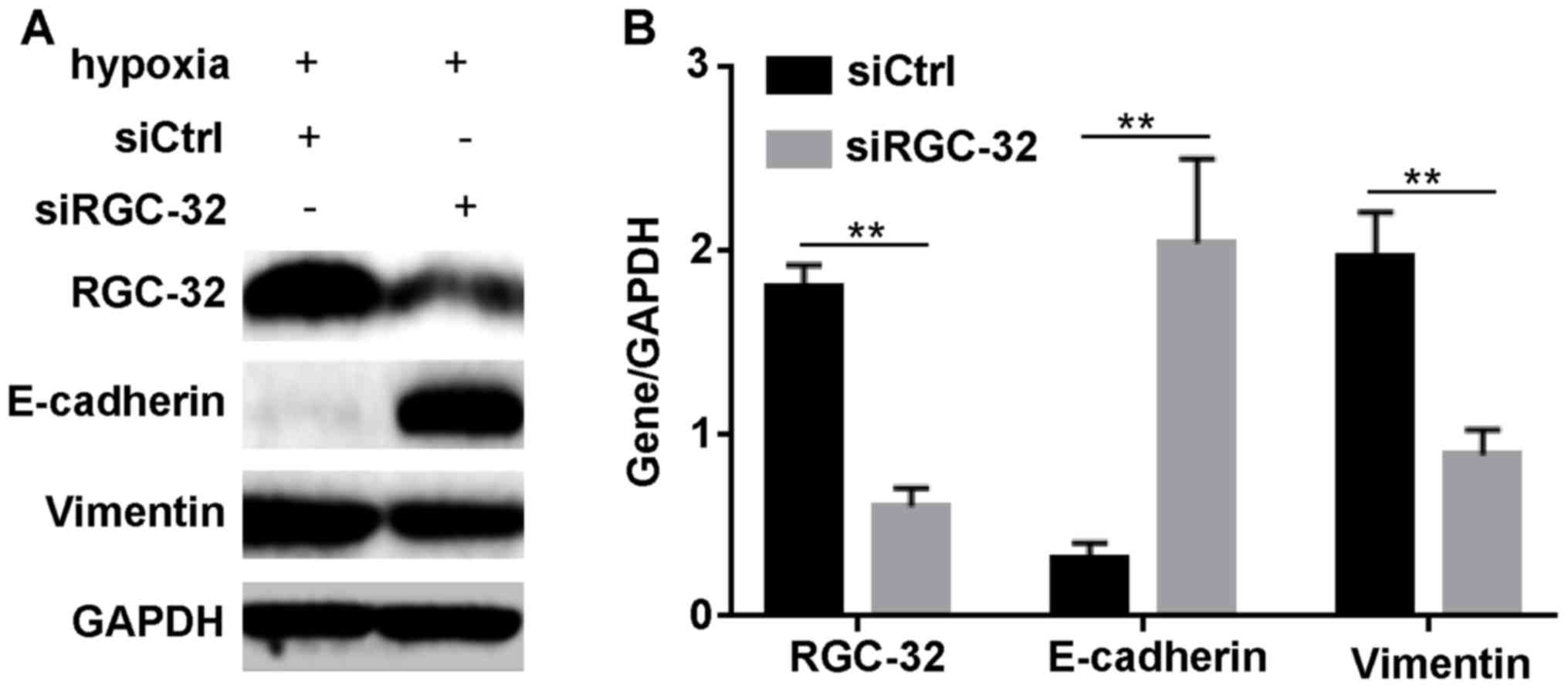Hypoxia‑inducible factor 1α participates in hypoxia‑induced epithelial‑mesenchymal transition via response gene to complement 32
- Authors:
- Published online on: June 23, 2017 https://doi.org/10.3892/etm.2017.4665
- Pages: 1825-1831
Abstract
Introduction
Pancreatic cancer is a highly lethal human gastrointestinal cancer (1). Although increasing methods are being applied for pancreatic cancer treatment, such as surgical resection and radiotherapy, the 5-year relative survival rate remains very dismal. A potential reason for the failure of the classical therapeutic approach may be explained by its high metastatic potential (2). Thus, it is critical to reveal the metastasis mechanism of pancreatic cancer. Epithelial-mesenchymal transition (EMT), the conversion from an epithelial to a mesenchymal phenotype, is a vital process for cancer invasion to surrounding tissues or metastasis to other organs (3). During the process of EMT, typical morphological changes occur, such as cell invasion and motility (4). The molecular indicators for EMT are the decrease of epithelial markers, such as E-cadherin, and the increase in the levels of mesenchymal markers, such as N-cadherin and vimentin (5). Significant efforts are required to investigate the mechanism of EMT for cancer control and the improvement of cure rate.
Response gene to complement 32 (RGC-32), first identified in 1998, is induced by complement and involved in cell cycle activation (6). RGC-32 is comprehensively expressed in the placenta, skeletal muscle, kidney, pancreas and aortic endothelial cells (7). It was reported that RGC-32 was also overexpressed in various types of cancer, such as colon cancer (8); however, had various complex roles in different cancer types (9). Transforming growth factor-β (TGF-β) and its downstream signal molecules have been demonstrated to have an essential role in the EMT of various types of cancer (9). In human renal proximal tubular cells (10) and pancreatic cancer cell line BxPC-3 (11), RGC-32 mediated TGF-β-induced EMT. To the best of our knowledge, a hypoxic microenvironment is common in the majority of solid tumors and is associated with the EMT of tumors (12). A vast number of clinical studies have suggested that hypoxia and hypoxia-induced signaling pathways are closely related to the poor outcome of tumor patients (13,14). Although increasing evidence has indicated that hypoxia may induce EMT (15), the relationship between RGC-32 and hypoxia-induced EMT is not fully understood.
Hypoxia-inducible factor 1 (HIF-1) is a transcriptional activator and is involved in a lot of pathophysiological processes under hypoxia (16). HIF-1 consists of an oxygen-sensitive α subunit (HIF-1α) and a constitutively expressed β subunit (HIF-1β) (17). Under hypoxia, HIF-1α regulates the expression of target genes by binding to the core sequence at the promoter region of the target genes (18). For example, it was reported that renalase, an amine oxidase secreted by the proximal tubule, was upregulated by hypoxia via a HIF-1α-dependent mechanism (19,20). HIF-1α is closely associated with the invasion, metastasis and prognosis of tumors (21).
In the present study, a cell model of hypoxia-induced EMT was constructed and it was demonstrated that repression of HIF-1α with HIF-1α inhibitor or small interfering (si)RNA transfection suppressed hypoxia-induced HIF-1α, RGC-32, N-cadherin and vimentin, but increased the expression of E-cadherin and cytokeratins inhibited by hypoxia. Furthermore, it was also observed that inhibition of RGC-32 by siRNA transfection upregulated the expression of E-cadherin, but impaired the protein expression level of vimentin. These data suggested that hypoxia activated the expression of HIF-1α, then increased the levels of RGC-32, in turn to modulate the EMT-related proteins for EMT. These findings increased the understanding about the function of RGC-32 in hypoxia-induced EMT and may have identified a novel target for pancreatic cancer treatment.
Materials and methods
Reagents
RPMI-1640 and α-minimal essential medium were purchased from Gibco (Thermo Fisher Scientific, Inc., Waltham, MA, USA). Negative control siRNA (NC siRNA, CCT ACA TCC CGA TCG ATG ATG TT), HIF-1α-Homo-488 siRNA (CTG ATG ACC AG CAA CTT GA), HIF-1α-Homo-1216 siRNA (CCT ATA TCC CAA TGG ATG ATG TT) and RGC-32 siRNA (siRGC-32, CAG ATT CAC TTT ATA GGA A) were purchased from GenePharma Technology Co., Ltd. (Shanghai, China). Lipofectamine RNAi MAX reagent (cat. no. 13778-150) was purchased from Invitrogen (Thermo Fisher Scientific, Inc.). RNA isolation kit (cat. no. 74104) was purchased from Qiagen GmbH (Hilden, Germany). SuperReal PreMix Color (cat. no. FP215-02) was purchased from Tiangen Biotech Co., Ltd., (Beijing, China). Antibodies against HIF-1α (cat. no. ab51608), E-cadherin (cat. no. ab40772), N-cadherin (cat. no. ab98952) and vimentin (cat. no. ab8978) were purchased from Abcam (Cambridge, MA, USA). RGC-32 antibody (cat. no. sc-84222) was purchased from Santa Cruz Biotechnology, Inc., (Dallas, TX, USA). GAPDH antibody (cat. no. AP0063) was purchased from Bioworld Technology Inc., (St. Louis Park, MN, USA). Horseradish peroxidase (HRP)-labeled secondary antibody (cat. no. LK-GAR007) was purchased from MultiSciences (Lianke) Biotechnology Co. Ltd. (Hangzhou, China). Radioimmunoprecipitation assay (RIPA) buffer (cat. no. PP1901) was purchased from BioTeke Corp., (Beijing, China). HIF-1α inhibitor (cat. no. HY12033) was purchased from MedChem Express company (Monmouth Junction, NJ, USA).
Cell culture and siRNA transfection
Human pancreatic cancer BxPC-3 cell line was purchased from Hibio Bio-tech Co., Ltd (Hangzhou, China). BxPC-3 cells were seeded into 6-well plates at a density of 1×105/well with RPMI-1640 medium supplemented with 10% fetal bovine serum (Gibco; Thermo Fisher Scientific, Inc.). When the confluence reached 70–80%, siRNA transfections were performed according to the manufacturer's instructions. Briefly, HIF-1α siRNA and Lipofectamine RNAi MAX reagent was diluted with Opti-MEM (Gibco; Thermo Fisher Scientific, Inc.) at room temperature for 5 min. The diluted Lipofectamine was added into siRNA dilution and placed at room temperature for an additional 5 min. Subsequently, the mixture was added into the wells with a final concentration of 20 nM siRNA. Cells were incubated at 37°C in a humidified atmosphere with 5% CO2 overnight. The following morning, cells were placed in fresh RPMI-1640 medium supplemented with 10% fetal bovine serum and incubated in hypoxic conditions, at 5%CO2+1%O2+94%N2 for 48 h at 37°C. Control cells received the same amount of negative control (NC) siRNA.
Reverse transcription-quantitative polymerase chain reaction (RT-qPCR)
Total RNA was isolated from BxPC-3 cells with TRIzol (Invitrogen; Thermo Fisher Scientific, Inc.). The concentration of RNA was determined by measuring the absorbance at 260 and 280 nm using Merinton SMA4000 (Merinton, Inc., Beijing, China). For the RT reaction, random-primed cDNA was synthesized from 1 mg of total RNA using a PrimeScript™ RT reagent kit (Takara Biotechnology Co., Ltd., Dalian, China), according to the manufacturer's instructions. qPCR analysis was performed using SuperReal PreMix Color (SYBR-Green), according to the manufacturer's instructions, and detected on a CFX96™ Real-Time system (Bio-Rad Laboratories, Inc., Hercules, CA, USA) with the following thermal conditions: 50°C for 3 min, 95°C for 15 min, followed by 40 cycles each of 95°C for 10 sec, 57°C for 10 sec and 72°C for 40 sec. Reactions were performed in triplicate. Quantification was calculated using the 2−∆∆CT method (22) with GAPDH mRNA as an endogenous control. The primers for GAPDH, HIF-1α, RGC-32, E-cadherin, cytokeratins, vimentin and N-cadherin were synthesized by Sunny Biotech Co., Ltd. (Shanghai, China) and are listed in Table I.
Western blotting
BxPC-3 cells were divided into five groups: a) No treatment and cells under normoxia (5% CO2) at 37°C; b) cells under hypoxia (5% CO2 + 1% O2 + 94% N2) at 37°C; c) cells pretreated with HIF-1α inhibitor for 30 min, then incubated under hypoxia (5% CO2 + 1%O2 + 94% N2) at 37°C; d) cells transfected with negative control siRNA, then incubated under hypoxia (5% CO2 + 1% O2 + 94% N2) at 37°C; e) cells transfected with HIF-1α-Homo-1216 siRNA then cultured under hypoxia (5% CO2 + 1% O2 + 94% N2) at 37°C. After 48 h, cells were harvested and lysed with RIPA buffer. Cells were shaken repeatedly until completed lysed, followed by centrifugation at 12,000 × g for 20 min at 4°C. Concentrations of proteins from the above five groups were determined using the bicinchoninic acid method. Protein samples were boiled for 5–10 min for further experiments. Proteins (30–50 µg) per sample were subjected to 12% SDS-PAGE and transferred to polyvinylidene fluoride membranes. Subsequent to blocking using 5% milk in Tris-buffered saline with 0.1% Tween-20 (TBST) at room temperature for 2 h, the blots were probed with antibodies specific for the proteins of interest, including RGC-32 (1:250) E-cadherin, cytokeratins, vimentin and N-cadherin (all 1:1,000) at 4°C overnight. Respective membranes were incubated with HRP-labeled secondary antibody (1:5,000) for 1 h at room temperature after the membranes were washed with TBST three times. Finally, the expression signals were detected with an enhanced chemiluminescence detection system (Pierce; Thermo Fisher Scientific, Inc.) and captured with a ChemiDoc XRS + System (Bio-Rad Laboratories, Inc.). To measure the protein levels, the bands of the western blots were measured with ImageJ Plus software v1.63 (National Institutes of Health, Bethesda, MD, USA), and the gray value of each target protein was calculated by comparison with GAPDH expression.
Statistical analysis
All experiments were repeated at least three times, and representative experiments were demonstrated. Data were expressed as the mean ± standard deviation. Statistical analysis was performed using SPSS v. 13.0 software (SPSS, Inc., Chicago, IL, USA). Student's two-tailed t-tests were applied for comparison of two independent experimental groups. P<0.05 was considered to indicate a statistically significant difference.
Results
siRNA targeted to HIF-1α successfully inhibits the expression of HIF-1α
To screen the effectiveness of HIF-1α siRNA, siRNA transfection experiments were conducted and the protein expression level of HIF-1α was detected by western blotting. As demonstrated in Fig. 1A and B, compared with the no treatment control group (CK), negative control (NC) siRNA incubation had no significant effect on the protein expression level of HIF-1α (P>0.05). However, various siRNA targeted to HIF-1α had a different effect on the expression of HIF-1α. Compared with the NC siRNA group, both HIF-1α-Homo-488 siRNA and HIF-1α-Homo-1216 siRNA significantly suppressed the expression of HIF-1α (P<0.01); however, HIF-1α-Homo-1553 siRNA did not significantly affect the protein expression level of HIF-1α. Furthermore, HIF-1α-Homo-1216 siRNA had a more significant effect on the expression of HIF-1α. Therefore, HIF-1α-Homo-1216 siRNA was selected for further experiments.
HIF-1α regulates mRNA and protein expression levels of RGC-32 and EMT-associated genes induced by hypoxia
To determine the role of HIF-1α in hypoxia-induced EMT in BxPC-3 cells, the expression of HIF-1α was blocked withHIF-1α-Homo-1216 siRNA and the expression of EMT markers was assessed. As demonstrated in Fig. 2, hypoxia incubation significantly increased the mRNA expression level of HIF-1α, RGC-32, N-cadherin and vimentin compared with no treatment cells under normoxia (P<0.05). However, the HIF-1α inhibitor pretreatment significantly suppressed the upregulation of these genes induced by hypoxia (P<0.05). HIF-1α-Homo-1216 siRNA significantly inhibited the mRNA expression levels of HIF-1α, RGC-32, N-cadherin and vimentin compared with the NC siRNA group (P<0.01). It was also demonstrated that hypoxia significantly suppressed the expression of E-cadherin and cytokeratins compared with no treatment cells under normoxia (P<0.05), and this inhibition was significantly released by HIF-1α inhibitor (P<0.05). Compared with the NC siRNA group, HIF-1α-Homo-1216 siRNA transfection significantly upregulated the transcripts of E-cadherin and cytokeratins (P<0.05 and P<0.01, respectively; Fig. 2).
To further examine the effect of HIF-1α on the protein levels of RGC-32 and EMT-related proteins, western blotting was conducted following siRNA transfection, as demonstrated in Fig. 3. The results were similar to the RT-qPCR data. HIF-1α inhibitor and siRNA significantly suppressed the expression of HIF-1α, RGC-32, N-cadherin and vimentin induced by hypoxia, but released the protein expression levels of E-cadherin and cytokeratins inhibited by hypoxia (P<0.01). These results demonstrated that HIF-1α regulated the expression of EMT markers, and hypoxia induced the expression of RGC-32 via HIF-1α.
Inhibition of RGC-32 modulates expression levels of EMT-related proteins
According to the aforementioned results, it was hypothesized that HIF-1α regulated BxPC-3 cell EMT through RGC-32. To validate this hypothesis, the effect of the inhibition of RGC-32 on the expression of EMT-associated proteins after hypoxia induction was examined. As demonstrated in Fig. 4, RGC-32 was successfully diminished by siRGC-32 under hypoxia. Compared with siCtrl incubation, siRGC-32 transfection significantly increased the expression of epithelial marker, E-cadherin (P<0.01); however, it significantly diminished the hypoxia-induced changes in the interstitial marker, vimentin (P<0.01). These data indicated that RGC-32 regulated the expression of EMT markers under hypoxia.
Discussion
Pancreatic cancer is a human malignancy with one of the highest mortality rates and little progress has been achieved in its treatment in recent decades. The molecular mechanism underlying HIF-1α and RGC-32 function in hypoxia-induced EMT remains largely unknown. The present study investigated the role of HIF-1α in hypoxia-induced EMT by siRNA transfection in human pancreatic cell line BxPC-3. Repression of HIF-1α modulated the expression of EMT-related proteins under hypoxia induction. In addition, knockdown of RGC-32 upregulated E-cadherin and downregulated vimentin. Therefore, the upregulation of HIF-1α induced by hypoxia increased the expression of RGC-32 to modulate the levels of EMT-associated proteins for EMT. These results indicated the function of RGC-32 in hypoxia-induced EMT.
HIF-1 acts as a master regulator of oxygen-regulated gene expression in response to hypoxia (23). Under hypoxia, HIF-1α homodimerizes with HIF-1b to mediate nuclear translocation and to activate the expression of target genes by binding to hypoxic responsive elements in the promoter regions (24). The high expression of HIF-1α was reported to correlate with tumor metastasis and poor clinical outcomes (13). Research has demonstrated that hypoxia induced the expression of HIF-1α to activate the process of EMT (25). A variety of biomarkers have been used to demonstrate EMT, such as epithelial markers (E-cadherin and cytokeratin) and mesenchymal markers [N-cadherin, vimentin, fibronectin and α smooth muscle actin (α-SMA)] (26). In human lens epithelial cells, the inhibition of HIF-1α downregulated the expression of two EMT early markers, fibronectin and α-SMA (27). In follicular thyroid cancer FTC133 cells, hypoxia induced HIF-1α expression was demonstrated to regulate the Twist signal and to induce EMT (17). Hypoxia induced EMT in mesothelial cells occurs via the activation HIF-1α and regulation of the expression of E-cadherin and vimentin (28). In the present study, it was indicated that the inhibition of HIF-1α by HIF-1α siRNA or HIF-1α inhibitor impaired the upregulation of RGC-32, N-cadherin and vimentin induced by hypoxia, and increased the expression of E-cadherin and cytokeratins, which were similar to the previous reports. These findings revealed the mechanism of HIF-1α involvement in hypoxia-induced EMT and provided novel insight into a possible therapeutic strategy to prevent hypoxia-induced EMT in pancreatic cancer.
TGF-β and hypoxia are believed to be the two major inducers of EMT (29). RGC-32 was revealed to be involved in the TGF-β-induced EMT process for tumor invasion (11). However, little was revealed about the function of RGC-32 in hypoxia-induced EMT in tumor cells. In the present study, it was demonstrated that hypoxia induced the expression of RGC-32 and the silencing of HIF-1α suppressed the expression of RGC-32 activated by hypoxia in BxPC-3 cells. These data were similar to a previous study, which indicated that HIF-1α and vascular endothelial growth factor significantly increased RGC-32 expression in hypoxia and ischemia (30). In addition, the present study indicated that the knockdown of RGC-32 significantly inhibited the expression of vimentin and upregulated E-cadherin under hypoxia. In BxPC-3 cells, TGF-β stimuli upregulated RGC-32 expression to suppress the level of E-cadherin for EMT (11). It was believed that RGC-32 was involved in hypoxia-induced EMT. As RGC-32 participated in hypoxia and TGF-β induced EMTs, RGC-32 was able to provide a novel link about the study on the relationship between two types of EMT.
In conclusion, the present study demonstrated that RGC-32, as a downstream gene of HIF-1α, induced by hypoxia, is a promoter of hypoxia-induced EMT in human pancreatic cancer BxPC-3 cells. RGC-32 activates hypoxia-induced EMT through mediating the expression of EMT-related proteins. Therefore, RGC-32 may be a potential therapeutic target for the treatment of pancreatic cancer.
Acknowledgements
The present study was supported by the National Natural Science Foundation of China (grant no. 81302152) and the Project of Health and Family Planning Commission of Jiangxi Province (grant no. 20155207).
Glossary
Abbreviations
Abbreviations:
|
EMT |
epithelial-mesenchymal transition |
|
HIF-1α |
hypoxia-inducible factor 1α |
|
RGC-32 |
response gene to complement 32 |
|
RT-qPCR |
reverse transcription-quantitative polymerase chain reaction |
|
TGF-β |
transforming growth factor-β |
References
|
Muniraj T, Jamidar PA and Aslanian HR: Pancreatic cancer: A comprehensive review and update. Dis Mon. 59:368–402. 2013. View Article : Google Scholar : PubMed/NCBI | |
|
Keane MG, Bramis K, Pereira SP and Fusai GK: Systematic review of novel ablative methods in locally advanced pancreatic cancer. World J Gastroenterol. 20:2267–2278. 2014. View Article : Google Scholar : PubMed/NCBI | |
|
Fan YL, Zheng M, Tang YL and Liang XH: A new perspective of vasculogenic mimicry: EMT and cancer stem cells (Review). Oncol Lett. 6:1174–1180. 2013.PubMed/NCBI | |
|
Lima J Felipe, Nofech-Mozes S, Bayani J and Bartlett JM: EMT in breast carcinoma-A review. J Clin Med. 5(pii): E652016. View Article : Google Scholar : PubMed/NCBI | |
|
Rogers CD, Saxena A and Bronner ME: Sip1 mediates an E-cadherin-to-N-cadherin switch during cranial neural crest EMT. J Cell Biol. 203:835–847. 2013. View Article : Google Scholar : PubMed/NCBI | |
|
Badea TC, Niculescu FI, Soane L, Shin ML and Rus H: Molecular cloning and characterization of RGC-32, a novel gene induced by complement activation in oligodendrocytes. J Biol Chem. 273:26977–26981. 1998. View Article : Google Scholar : PubMed/NCBI | |
|
Badea T, Niculescu F, Soane L, Fosbrink M, Sorana H, Rus V, Shin ML and Rus H: RGC-32 increases p34CDC2 kinase activity and entry of aortic smooth muscle cells into S-phase. J Biol Chem. 277:502–508. 2002. View Article : Google Scholar : PubMed/NCBI | |
|
Fosbrink M, Cudrici C, Niculescu F, Badea TC, David S, Shamsuddin A, Shin ML and Rus H: Overexpression of RGC-32 in colon cancer and other tumors. Exp Mol Pathol. 78:116–122. 2005. View Article : Google Scholar : PubMed/NCBI | |
|
Vogelmann R, Nguyen-Tat MD, Giehl K, Adler G, Wedlich D and Menke A: TGFbeta-induced downregulation of E-cadherin-based cell-cell adhesion depends on PI3-kinase and PTEN. J Cell Sci. 118:4901–4912. 2005. View Article : Google Scholar : PubMed/NCBI | |
|
Huang WY, Li ZG, Rus H, Wang X, Jose PA and Chen SY: RGC-32 mediates transforming growth factor-beta-induced epithelial-mesenchymal transition in human renal proximal tubular cells. J Biol Chem. 284:9426–9432. 2009. View Article : Google Scholar : PubMed/NCBI | |
|
Zhu L, Qin H, Li PY, Xu SN, Pang HF, Zhao HZ, Li DM and Zhao Q: Response gene to complement-32 enhances metastatic phenotype by mediating transforming growth factor beta-induced epithelial-mesenchymal transition in human pancreatic cancer cell line BxPC-3. J Exp Clin Cancer Res. 31:292012. View Article : Google Scholar : PubMed/NCBI | |
|
Shen X, Xue Y, Si Y, Wang Q, Wang Z, Yuan J and Zhang X: The unfolded protein response potentiates epithelial-to-mesenchymal transition (EMT) of gastric cancer cells under severe hypoxic conditions. Med Oncol. 32:4472015. View Article : Google Scholar : PubMed/NCBI | |
|
Ackerman D and Simon MC: Hypoxia, lipids, and cancer: Surviving the harsh tumor microenvironment. Trends Cell Biol. 24:472–478. 2014. View Article : Google Scholar : PubMed/NCBI | |
|
Choudhry H, Albukhari A, Morotti M, Haider S, Moralli D, Smythies J, Schödel J, Green CM, Camps C, Buffa F, et al: Tumor hypoxia induces nuclear paraspeckle formation through HIF-2α dependent transcriptional activation of NEAT1 leading to cancer cell survival. Oncogene. 34:45462015. View Article : Google Scholar : PubMed/NCBI | |
|
Jiang J, Tang YL and Liang XH: EMT: A new vision of hypoxia promoting cancer progression. Cancer Biol Ther. 11:714–723. 2011. View Article : Google Scholar : PubMed/NCBI | |
|
Zepeda AB, Pessoa A Jr, Castillo RL, Figueroa CA, Pulgar VM and Farias JG: Cellular and molecular mechanisms in the hypoxic tissue: Role of HIF-1 and ROS. Cell Biochem Funct. 31:451–459. 2013. View Article : Google Scholar : PubMed/NCBI | |
|
Yang YJ, Na HJ, Suh MJ, Ban MJ, Byeon HK, Kim WS, Kim JW, Choi EC, Kwon HJ, Chang JW and Koh YW: Hypoxia induces epithelial-mesenchymal transition in follicular thyroid cancer: Involvement of regulation of twist by hypoxia inducible factor-1α. Yonsei Med J. 56:1503–1514. 2015. View Article : Google Scholar : PubMed/NCBI | |
|
Weidemann A and Johnson RS: Biology of HIF-1alpha. Cell Death Differ. 15:621–627. 2008. View Article : Google Scholar : PubMed/NCBI | |
|
Wang F, Yin J, Lu Z, Zhang G, Li J, Xing T, Zhuang S and Wang N: Limb ischemic preconditioning protects against contrast-induced nephropathy via renalase. EBioMedicine. 9:356–365. 2016. View Article : Google Scholar : PubMed/NCBI | |
|
Wang F, Zhang G, Xing T, Lu Z, Li J, Peng C, Liu G and Wang N: Renalase contributes to the renal protection of delayed ischaemic preconditioning via the regulation of hypoxia-inducible factor-1α. J Cell Mol Med. 19:1400–1409. 2015. View Article : Google Scholar : PubMed/NCBI | |
|
Tian Q, Xue Y, Zheng W, Sun R, Ji W, Wang X and An R: Overexpression of hypoxia-inducible factor 1α induces migration and invasion through Notch signaling. Int J Oncol. 47:728–738. 2015.PubMed/NCBI | |
|
Livak KJ and Schmittgen TD: Analysis of relative gene expression data using real-time quantitative PCR and the 2(−Delta Delta C(T)) Method. Methods. 25:402–408. 2001. View Article : Google Scholar : PubMed/NCBI | |
|
Semenza GL: Oxygen sensing, hypoxia-inducible factors, and disease pathophysiology. Annu Rev Pathol. 9:47–71. 2014. View Article : Google Scholar : PubMed/NCBI | |
|
Gao T, Li JZ, Lu Y, Zhang CY, Li Q, Mao J and Li LH: The mechanism between epithelial mesenchymal transition in breast cancer and hypoxia microenvironment. Biomed Pharmacother. 80:393–405. 2016. View Article : Google Scholar : PubMed/NCBI | |
|
Balamurugan K: HIF-1 at the crossroads of hypoxia, inflammation, and cancer. Int J Cancer. 138:1058–1066. 2016. View Article : Google Scholar : PubMed/NCBI | |
|
Zeisberg M and Neilson EG: Biomarkers for epithelial-mesenchymal transitions. J Clin Invest. 119:1429–1437. 2009. View Article : Google Scholar : PubMed/NCBI | |
|
Cammarata PR, Neelam S and Brooks MM: Inhibition of hypoxia inducible factor-1α downregulates the expression of epithelial to mesenchymal transition early marker proteins without undermining cell survival in hypoxic lens epithelial cells. Mol Vis. 21:1024–1035. 2015.PubMed/NCBI | |
|
Morishita Y, Ookawara S, Hirahara I, Muto S and Nagata D: HIF-1α mediates Hypoxia-induced epithelial-mesenchymal transition in peritoneal mesothelial cells. Ren Fail. 38:282–289. 2016. View Article : Google Scholar : PubMed/NCBI | |
|
Heldin CH, Landström M and Moustakas A: Mechanism of TGF-beta signaling to growth arrest, apoptosis, and epithelial-mesenchymal transition. Curr Opin Cell Biol. 21:166–176. 2009. View Article : Google Scholar : PubMed/NCBI | |
|
An X, Jin Y, Guo H, Foo SY, Cully BL, Wu J, Zeng H, Rosenzweig A and Li J: Response gene to complement 32, a novel hypoxia-regulated angiogenic inhibitor. Circulation. 120:617–627. 2009. View Article : Google Scholar : PubMed/NCBI |













